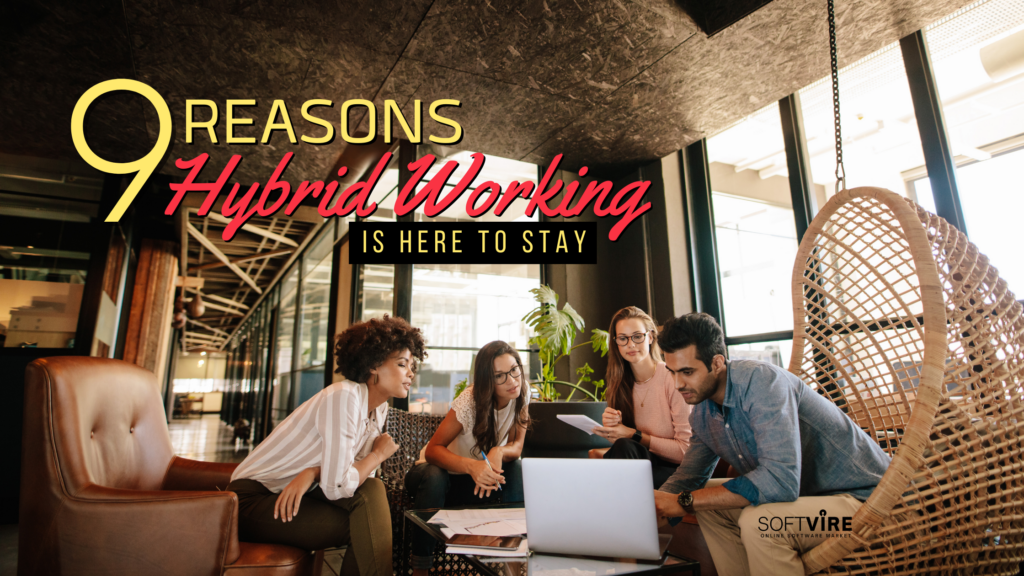As the number of immunized people grows, business is gradually returning to normal. For many businesses, the “normal” schedule, location, and hours of operation are becoming obsolete. The majority of employees want to keep getting this benefit even after flu season is past, demonstrating that they can be just as effective working from home as they were the previous year.
The hybrid concept was first used in experimental situations. However, a more permanent structure is emerging over time. Microsoft, for example, permits its employees to telecommute half of the time. Salesforce, Dropbox, Shopify, Facebook, Zillow, and Viacom are just a few well-known companies that have made the transition to a more flexible work environment.
As businesses return to the office, hybrid workspaces have grown in popularity, exhibiting the space’s versatility.
In this article, we will look at seven benefits of hybrid work that will assure its popularity in the future:
-
Increased Employee Happiness and Productivity
Employees are more productive when they have the freedom to use their skills to their full capacity, which is frequently the case in a hybrid work paradigm. With the support of the hybrid work paradigm, employees may select the environment that is most favorable to their job. While some people flourish when working remotely, others prefer a distraction-free office atmosphere. Employees are more satisfied with their jobs when they may work from home, the office, or a combination of the two. Furthermore, this flexibility may result in a healthier work-life balance, which has a substantial influence on employee happiness.
-
It Helps Employees Find a Better Balance between Work and Life
As a result of the pandemic, everyone has given considerable thought to their life priorities. Regardless of our hobbies, needs, and objectives, we all desire personal and professional mobility.
Because of the pandemic, workers today want flexibility more than ever. This is because we’ve all had experience working remotely and seen the benefits it can give. Employees in a mixed work arrangement can choose their own priorities and decide how to best combine work and personal duties. Taking care of children, assisting families, and protecting our mental health are all made easier by hybrid work.
-
More Chances to Learn New Things All the Time
Another significant benefit of the hybrid work paradigm is the ability for individuals to continue their education outside of the office. They may boost their productivity and career opportunities by working part-time from home and going to the office the other four days of the week.
-
It Makes Work Safer
COVID-19’s spread is unavoidable. Even if vaccines reduce the severity of symptoms and routine testing helps detect asymptomatic cases and protect people at greatest risk, the sickness will remain a threat for a long time, if not forever. Another thing to consider is that some people just cannot be vaccinated for different reasons.
Under a hybrid structure, fewer people are physically present at the office during peak hours. There will always be a rolling roster of people who work from home and others who work from the office. This allows you to communicate with faraway loved ones, soothe worried employees, and protect the safety of your most vulnerable coworkers.
-
It Lowers the Cost of Doing Business
A hybrid office structure allows organizations to make greater use of their space. With more individuals working from home, 31 percent of CEOs questioned by PWC believe the necessity for office space is decreasing. Managers have experimented with workplace arrangement. Small conference rooms, for example, are increasingly being used as locations for individuals to work on projects. Individual workplaces have now been established.
Hot desking and hoteling have largely replaced conventional techniques of worker separation. When the price of a structure is reduced, so is the cost of running it. Businesses’ rents might be dramatically cut. Furthermore, less infrastructural modifications are necessary. This is why many businesses have stuck with the mixed-work model.
-
Better Results for Mental Health
Many people have discovered that working from home enhances their mental well-being. It was a huge relief to be able to work from home and escape the stress of typical employment considerations like commuting to and from the office and staying late to complete work. Employees who were given more freedom to make health and fitness decisions had a better chance of success. People who excelled in a team situation at work may have suffered more on their own. Employees in a hybrid-work paradigm can work remotely, in-person, or a combination of the two. This promotes a better work-life balance and mental health for people who choose either type of employment.
-
It Helps Your Business Get Ready for the Future
We can all agree that, unlike the transitory trends that existed before to the epidemic, hybrid and flexible employment arrangements are here to stay. Everyone hopes that the coronavirus will be eradicated forever, but there is no way to know for certain. Even if it is, what if another pandemic erupts?
Firms must plan for the unexpected by including some slack into their processes. Companies and employees alike would prefer that if another epidemic occurs, things do not go as badly as they did in early 2020.
-
Improved Teamwork and Relationships
A hybrid work paradigm, as opposed to working remotely, promotes employees to meet and communicate in person, which is beneficial to team morale and productivity. More possibilities for employees to interact in person not only helps them establish professional connections, but also enables cooperation across divisions, teams, and other workgroups. This is especially important in modern businesses, where many employees choose to connect with one another via technological methods. If you conduct the majority of your job from home, in-person meetings may be your only opportunity to network with peers and get vital knowledge and assistance.
-
Hybrid Working Option is Now a Staple Among Most Companies
Working from home or an office is one reason a hybrid work paradigm will persist. Slack polled 3,480 remote workers and found that 63% preferred a hybrid work arrangement, 20% wanted to work remotely full-time, and 12% wanted to return to the office. More 25-34-year-olds wanted hybrid jobs. They liked hybrid work. Work-from-home allowed many employees to be more productive and have a better work-life balance. Office employment has benefits. Collaboration, professional connections, guidance, and culture shaping are still great in the office.
We’re at a turning point. The way and where we operate has changed irreversibly. The pandemic and flexible working from home prevent us from returning. Many economists and analysts call this moment the “Great Upheaval,” and Microsoft data suggests that 41% of the working population will abandon their jobs this year.
Many commuters have found that their time might have been better spent on personal growth, health and well-being, family and friends, or doing something they like. Working from home in little silos with no colleague interaction might lead to digital fatigue.
These discoveries may affect hybrid work’s future. First, it shows that people worldwide have experienced flexible work and are willing to abandon their jobs to have more freedom from the 9-to-5 workday. It also shows that working from home is not for everyone; many individuals miss working together, making friends, learning, and growing in an office.
Some of these duties may be done from home, but face-to-face interaction is the best way to improve collaboration, professional connections, and corporate culture.
Conclusion
Due to the need for independence, flexibility, and face-to-face engagement, hybrid work paradigms are best for post-pandemic businesses. As said, a hybrid work paradigm boosts productivity, employee happiness, continual learning, collaboration, and mental wellness. Hybrid work is the most flexible because it gives people what they’ve wanted for years: a better work-life balance. Many say things have improved.
As firms evolve and adapt to the unknowns of today and tomorrow, developing a hybrid workplace that promotes collaboration, productivity, and development will take careful planning and preparation.



